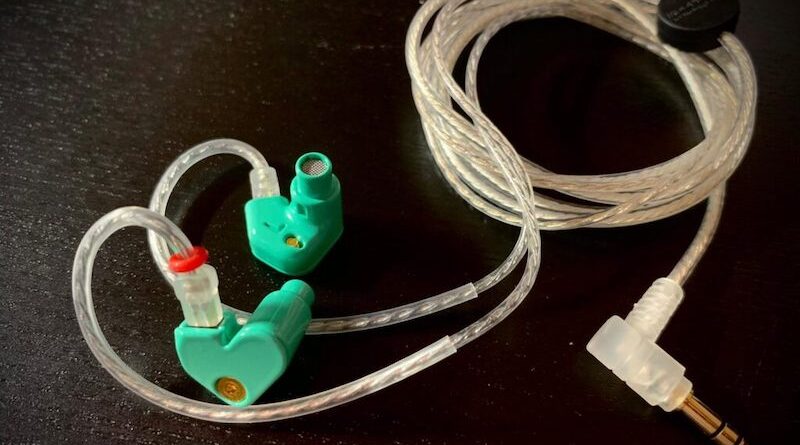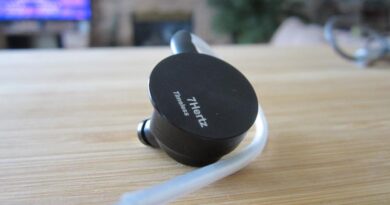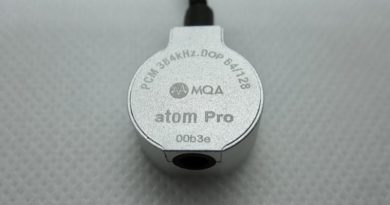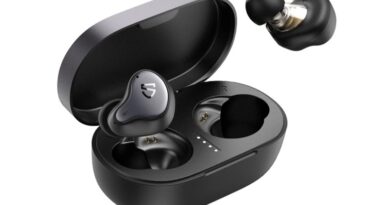Moondrop SSR Review (2) – Shouting At The Moon
Pros
Good fit and comfortable. Light.
Excellent technicalities for a budget single DD such as good clarity, details and imaging.
Authentic timbre for acoustic instruments.
Cons:
Shouty at 3 kHz region, especially at louder volumes (Fletcher Munson curve).
Sibilance fest.
Fatiguing with longer listening sessions.
Thin note weight. Brittle female vocals.
Not all rounder due to the lack of bass. Basslite with a lack of subbass rumble.
Below average isolation.
Not that easy to drive.

EXECUTIVE SUMMARY
The Moondrop SSR is a budget single DD set that is tuned somewhat diffuse-field neutral with an upper mids boost. It has excellent technicalities and timbre (for acoustic instruments), but unfortunately the upper mids do get shouty especially at louder volumes (Fletcher Munson curve). Sibilance is also present in spades. It sounds good at low volumes, but those who like to blast their music may need to look elsewhere. In addition, it may not be an all rounder due to the lack of bass, and the tuning is quite niche to say the least. Having said that, the Moondrop SSR has one of the best technical performances for a sub $40 USD single DD set.

SPECIFICATIONS
- Driver Unit: Beryllium Coated Dome + PU Suspension Ring
- Sensitivity: 115 dB
- Frequency response: 20Hz – 20000Hz
- Impedance: 16 ohms
- Cable: 2 pin detachable 0.78 mm
- Tested at $39.99 USD

ACCESSORIES
In addition to the IEM, it comes with:
- Silicone eartips (S/M/L).
- Silver-Plated 4N-Litz Oxygen-Free Copper (OFC) cable – For non cable believers, nothing to see here, please move on. If you are a cable believer, I prefer pure copper cables on the Moondrop SSR as they seem to me to tone down the treble/upper mids a tinge compared to the stock SPC cable.
- Carrying pouch
- Anime waifu box – Never ever underestimate the power of the anime designed box
marketing. For some, it may actually be the most important item in this purchase, more important than the IEM itself!

For the purposes of this review, I stuck with the provided stock cable and tips, but I personally preferred Final E tips with the Moondrop SSR, as they helped to tame the sibilance and upper mids spike a tinge. I also preferred copper cables with the Moondrop SSR to add a bit of bass warmth, but YMMV as we have different ear anatomies and beliefs in cables.

BUILD/COMFORT
The Moondrop SSR is actually much smaller than it looks, and it is heart shaped and made of sturdy metal. It is very comfortable and light, I can wear it for hours with no issues. I didn’t detect any driver flex.
I liked that it came with a 2 pin connector, as I’m not a fan of MMCX connectors due to potential longevity issues.

ISOLATION
Isolation on the Moondrop SSR is below average. Personally, I wouldn’t bring it for commuting due to the poor isolation letting it outside noise, for which one may try to boost the volume to overcome the external noise, and this is not good for hearing health in the long term.
Secondly, bass frequencies are the first to be lost in a noisy environment, and the Moondrop SSR is already bass lite to begin with. So from my subway trip with the Moondrop SSR, I lost a lot of bass frequencies in my music and as the ears take the frequency spectrum as a whole, the upper mids 3 kHz peak could get very hot, especially if one tries to pump up the volume to compensate for the bass loss.

DRIVABILITY/SOURCE
I tried running the Moondrop SSR with a Khadas Tone Board -> Toppping L30, Khadas Tone Board -> Fiio A3 amp, Shanling Q1 DAP, Ziku HD X9 DAP -> Fiio A3 amp, a low powered smartphone and the Tempotec Sonata HD Pro.
The Moondrop SSR is actually not the easiest to drive, and scales better with amping.
Also, as the Moondrop SSR is on the brighter side, I find that pairing it with warmer sources manages to give the bass a bit more heft and evens out the 3 kHz area peak. Analytical sources may overemphasize the glare of the 3 kHz region and sibilance, so for my preferences, I wouldn’t recommend it.

SOUND & TECHNICALITIES



The Moondrop SSR is tuned somewhat diffuse-field neutral with an upper mids boost. This said upper mids area is pretty controversial and has very polarizing opinions. The Moondrop SSR actually sounds very good at low volumes, but those who like to blast their music may need to look elsewhere. The upper mids 3 kHz area gets shouty especially when the volume is increased (Fletcher Munson curve), with sibilance in spades. Most users/reviewers do not mention the volume they play their music at, but the Fletcher Munson curve really affects this set a lot, so this may explain the polarizing reviews we see about it.
Having said that, other than volume, upper mids/treble sensitivity is a very personal thing, since we all have different hearing health (due to age/occupation exposure/leisure exposure), different ear anatomy that may affect the pinna gain, and we also use different sources, different tips and have different levels of treble sensitivity/trebleheadedness. I know some friends who really like the Moondrop SSR (but they are low volume listeners or those that like a brighter signature), so YMMV.
The Moondrop SSR thankfully has very good technicalities for the price, considering it is a sub $40 USD single DD set. Lately there have been a lot of beryllium (coated/plated) single DD releases, of which the Moondrop SSR is one of them, I’m still on the fence whether this is a marketing gimmick or not. But for sure, I can say the imaging in the Moondrop SSR is very good, with good clarity, instrument separation and details too. Transient speed in the Moondrop SSR is fast, possibly due to the said beryllium drivers. I dare say the Moondrop SSR probably beats most other single DDs in the sub $40 USD region in technical performance.
Soundstage width and height on the Moondrop SSR is above average, depth is about slightly more than average. Music didn’t sound too congested on the Moondrop SSR during complex movements.
Note weight on the Moondrop SSR is rather thin and the tonality is cold for me, with the tuning veering towards the analytical side. Timbre is accurate for acoustic instruments, but vocals sounded a bit brittle, especially for female vocals.

Bass:
The Moondrop SSR has a rather neutral midbass, with subbass roll off. The bass is quite well textured with minimal midbass bleed and good speed. The subbass lacks rumble, but then again, I’m a basshead, and though the Moondrop SSR’s bass is not my cup of tea in the area of quantity, the bass is of good quality.
This lack of bass quantity may render the Moondrop SSR not that versatile for certain genres where bass forward music is present, eg EDM. In addition, this lack of subbass actually compounds the boosted upper mids (which we will talk about in the next section), as the ears take the entire frequency spectrum as a whole, and this gives a somewhat shouty and harsh upper mids skewed tuning.

Mids:
The lower mids are pretty neutral on the Moondrop SSR, but then it spikes up around +10 dB in the upper mids, which as discussed above, is a big bone of contention. This is especially so when the volume is boosted (Fletcher Munson curve), as the ears perceive the sound to be more V shaped at higher volumes, whereas it is perceived to be more U shaped at softer volumes.
Female vocals are hence more forward than male vocals, and there are excellent microdetails and clarity especially along the upper mids. Trumpets and horns and higher vocals can get quite harsh at the 3 kHz regions, especially in poorly recorded material. Due to the huge dynamic differences from lower to upper mids, sometimes female vocals and violins “jump” out and adds a glare and an unnatural tonality. Personally, I’m rather sensitive to the 2 – 4 kHz areas, and the 3 kHz area is a dealbreaker for me for the Moondrop SSR, but as always, YMMV.

Treble:
Lower treble is about the same level as the aforementioned upper mids, but the higher treble has some roll off. Higher treble is actually quite safe for treble sensitive folks, and cymbals are emphasized but not splashy. Compared to the overcooked upper mids, thankfully the treble manages to gear down nicely. Microdetails and clarity are good in the treble. Unfortunately, the dreaded S word, sibilance is present, and in spades, especially when the volume is jacked up.

COMPARISONS
As per comparing apples to apples, I left out multi BA/hybrids/exotic drivers from the comparisons, as the different transducers have their inherent strengths and weaknesses. Also, since the Moondrop SSR is an upper mids boosted set, I decided to pick some budget single DD types that have a boosted upper mids for comparison:

HZSound Heart Mirror
The HZSound Heart Mirror is a neutralish bright single DD set. Both sets have good technical performance for a single DD set, maybe the Moondrop SSR edges it slightly in clarity, details and imaging. The Moondrop SSR has a better soundstage than the HZSound Heart Mirror. Timbre for acoustic instruments is very good in both sets. The Moondrop SSR has quite bad sibilance and a thinner note weight compared to the HZSound Heart Mirror. Isolation is better on the HZSound Heart Mirror.
After doing A/B testing using the same source, tips (and even cable), I’ll take the HZSound Heart Mirror any day over the Moondrop SSR, as the 3 kHz peak and the sibilance on the SSR is a deal breaker for me, whereas the HZSound Heart Mirror balances a very fine line of pushing forward vocals without going into shouty territory. The HZSound Heart Mirror is smoother and very rarely gets harsh or sibilant. The HZSound Heart Mirror also has a slightly deeper subbass extension, even though both are not basshead sets for sure.
To summarize, the Moondrop SSR actually has better technical performance than the HZSound Heart Mirror, but a worse tonality along the upper mids, so different strokes for different folks, it depends whether technicalities or tonality is a higher priority.

BLON BL-05S
The BLON BL-05S is a mild V shaped set, with a slightly boosted upper mids region and slightly boosted midbass. The BLON BL-05S has a warmer tonality and thicker note weight, with better isolation. The BLON BL-05S is the more bassy set and is less sibilant. Moondrop SSR is shoutier at the upper mids/lower treble than the BLON BL-05S, especially when used at louder volumes (Fletcher Munson Curve).
Moondrop SSR is the technical superior of the BLON BL-05S in the areas of better clarity, imaging, details and instrument separation. Moondrop SSR also has a slightly better acoustic instrumental timbre, and has better treble extension. They are rather different in tuning and would suit different sonic signatures/music preferences.

Tin T2 Plus
The Tin T2 Plus is U shaped, with more bass and less upper mids than the Moondrop SSR. Tin T2 Plus is more analoguish and warmer, though the Moondrop SSR has better technicalities and is more analytical. I find the Tin T2 Plus more balanced and very inoffensive in tuning, and it is pretty non fatiguing in contrast to the Moondrop SSR (especially at higher volumes). Note weight is thicker on the Tin T2 plus too, though I occasionally find it a bit lacking in dynamics. Due to the boosted bass, the Tin T2 Plus is more versatile in tuning, being more all rounded for more music genres than the Moondrop SSR.
The Tin T2 Plus is plague by MMCX QC issues though, there’s been quite a few reports in the forums (my set has a wonky MMCX too). I would strongly advise you to only buy the Tin T2 Plus from places with a robust returns policy (eg Amazon), in case a lemon comes in the mail.


CONCLUSIONS
The Moondrop SSR is a budget single DD set that is tuned somewhat diffuse-field neutral with an upper mids boost. It has excellent technicalities and timbre, but unfortunately the upper mids get shouty especially at louder volumes (Fletcher Munson curve), with sibilance. It sounds good at low volumes, but those who like to blast their music may need to look elsewhere. Most users/reviewers do not mention the volume they play their music at, but the Fletcher Munson curve really affects this set a lot, so this may explain the polarizing reviews we see about it. Having said that, other than volume, upper mids/treble sensitivity is a very personal thing, since we all have different hearing health (due to age/occupation exposure/leisure exposure), different ear anatomy that may affect the pinna gain, and we also use different sources, different tips and have different levels of treble sensitivity/trebleheadedness. So YMMV.
In addition to only using the Moondrop SSR at low to moderate volumes, I will also not take this set outdoors due to the suboptimal isolation. The Moondrop SSR is not an all rounder due to the lack of bass, and bass forward music does sound pretty flat on it.
As such, I would say the Moondrop SSR’s tuning is quite niche, and is probably not a universally safe recommendation for everyone, especially those that listen to bass forward music, or are treble/upper mids sensitive, or those who like to blast their music. I know some friends who like it though (they are low volume and indoor users and/or trebleheads), so different strokes for different folks. Even though personally this tuning is not my cup of tea, I still applaud what sets the Moondrop SSR apart, and that is the excellent technicalities at the sub $40 USD asking price for a single DD set. It really beats most of the other sub $40 USD single DD sets in this department. Timbre for acoustic instruments is also quite authentic on the Moondrop SSR.
I very much look forward to the upcoming Moondrop SSP (Pulse), which is supposed to be a bassier variant of the Moondrop SSR. Hopefully the SSP’s bassier frequencies counteract the upper mids peak (since our ears take the entire frequency spectrum as a whole), or at least Moondrop softens the 3 kHz area peak a bit, but still preserves the excellent technical performance of the Moondrop SSR. They might have a true gamechanger then, if the Moondrop SSP’s price is similar, especially since a bassier sound may also be more compatible with more music genres.

MY VERDICT

You find an INDEX of all our earphone reviews HERE.
DISCLAIMER
The Moondrop SSR was borrowed from coblogger KopiOKaya for the purposes of this review, and was returned after the review was done.

Our generic standard disclaimer.
You find an INDEX of our most relevant technical articles HERE.










